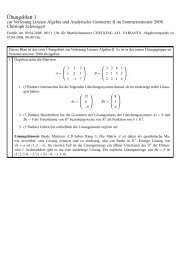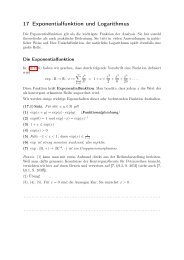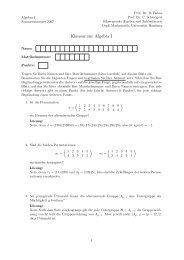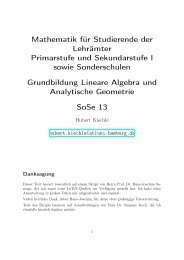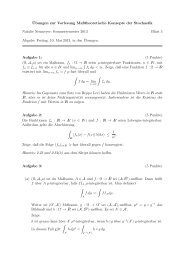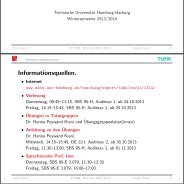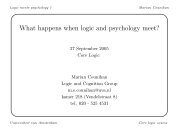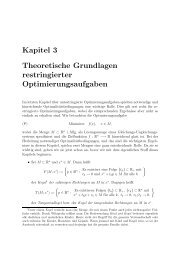pdf file
pdf file
pdf file
You also want an ePaper? Increase the reach of your titles
YUMPU automatically turns print PDFs into web optimized ePapers that Google loves.
3. A closed oriented manifold M of dimension n can be regarded as a bordism from the<br />
empty (n − 1)-manifold to itself, M : ∅ → ∅. Thus<br />
Z(M) : K ∼ = Z(∅) → Z(∅) ∼ = K<br />
and thus Z(M) ∈ Hom K (K, K) ∼ = K is a number: an invariant assigned to every closed<br />
oriented manifold of dimension n.<br />
Observation 4.1.7.<br />
Let Z be an n-dimensional topological field theory. For any closed oriented (n − 1)-dimensional<br />
manifold M, Z(M) is a vector space. The cylinder on M gives a bordism d M : M ∐ M → ∅<br />
which is a right evaluation. Similarly, we get a right coevaluation b M : ∅ → M ∐ M.<br />
Applying the functor Z, we get a vector space Z(M) together with another vector space<br />
Z(M) that is a right dual.<br />
We need two lemmas:<br />
Lemma 4.1.8.<br />
Let V be an object in a tensor category. Let (V ∨ , d V , b V ) and (Ṽ ∨ , ˜d V , ˜b V ) be two right duals.<br />
Then V ∨ and Ṽ ∨ are canonically isomorphic: there is a unique isomorphism ϕ : V ∨ → Ṽ ∨ , such<br />
that the two diagrams<br />
V ∨ ⊗ V<br />
<br />
ϕ⊗id V<br />
<br />
Ṽ ∨ ⊗ V<br />
V ⊗ V ∨<br />
<br />
id V ⊗ϕ<br />
V ⊗ Ṽ ∨<br />
d V<br />
˜d<br />
V<br />
I<br />
b V<br />
˜bV<br />
<br />
I<br />
<br />
commute.<br />
Proof.<br />
For simplicity, we assume that the tensor category is strict. The axioms of a duality imply that<br />
α : V ∨ id V ∨ ⊗˜b V<br />
−→<br />
V ∨ ⊗ V ⊗ Ṽ ∨ d V ⊗idṼ ∨<br />
−→<br />
Ṽ ∨<br />
and<br />
β : Ṽ ∨ id Ṽ ∨ ⊗b V<br />
−→<br />
are inverse to each other. Uniqueness is easy to see.<br />
Ṽ ∨ ⊗ V ⊗ V ∨ ˜d V ⊗id V ∨<br />
−→<br />
V ∨<br />
✷<br />
Lemma 4.1.9.<br />
A K-vector space V has a right dual, if and only if it is finite-dimensional.<br />
Proof.<br />
Consider the element<br />
b V (1) =<br />
N∑<br />
b i ⊗ β i with b i ∈ V and β i ∈ V ∗<br />
i=1<br />
which is necessarily a finite linear combination. Then by the axioms of a duality<br />
v = (id V ⊗ d V )(b V (1) ⊗ id V )(v) =<br />
N∑<br />
b i β i (v) .<br />
i=1<br />
86






